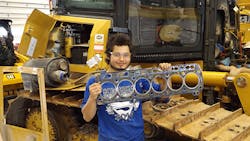Millennials Flocking to San Antonio – Manufacturing Pushing Education
San Antonio saw the biggest growth in millennial population of any U.S. city in 2014. And from 2000-2013 the population grew 30%.
Why San Antonio?
Maybe it’s the strong job market. The Brookings Institution, in 2014, named San Antonio one of the strongest-performing economies among the 100 largest metropolitan areas in the nation and #1 in overall performance based on employment and unemployment levels.
“We are focusing on this population,” explains Mario Hernandez, president of the San Antonio Economic Development Foundation. “We are ensuring that there is training available, especially in the manufacturing sector.”
And the city is home to a number of large manufacturing companies which include Boeing, Caterpillar, Frito-Lay, Johnson Controls, Lockheed Martin, Pratt & Whitney, Tenneco, Tyson and Toyota. In the past two years the city has added 18 new manufacturing facilities.
Hernandez points to the success of Toyota, which through its sheer number of employees, has trained many workers. Toyota, which has a long history in the city, began manufacturing in San Antonio in 2003, and continues to grow. This past September the company was looking hire another 200 workers to its 6,000 strong workforce at its San Antonio manufacturing which builds the full-size Tundra and midsize Tacoma pickup trucks.
The city’s efforts at workforce training attracted national attention when in 2015 it was one of 12 communities chosen by the U.S. Department of Commerce to join its Investing in Manufacturing Communities Partnership program. Communities that are part of the program receive preference when applying for federal grants to promote their local manufacturing industries. San Antonio applied as the Alamo Manufacturing Partnership, bringing together 13 partner organizations to collaboratively approach growing San Antonio’s manufacturing industry.
While the area has a strong population of community college and university students, which numbers 150,000, attracting students into the field of manufacturing is always a challenge.
“To help bring attention to workforce issues and solutions, I helped Texas passed House bill 5 which moved the focus from only sending kids to college and looked at the school’s ability to train in vocational technology,” Hernandez says.
An outgrowth of that effort is the Alamo Area Academies. This organization is a STEM-based instructional model operated by the Alamo Area Academies Inc., a non-profit organization, in partnership with the Alamo Colleges, San Antonio area high schools, industry and the cities of San Antonio, New Braunfels and Seguin.
It provides students with tuition-free career pathways into critical demand technical STEM occupations. The program utilizes contextualized industry-driven curricula resulting in 94% of graduates entering higher education or high-wage careers in aerospace, manufacturing, information technology and heavy equipment.
One company that has been involved in the heavy equipment segment of Alamo Academies is HOLT CAT. Established in 1933, HOLT sells and services Cat equipment and also fabricates its own line of custom engineered products including root plows and water tankers.
“As a company we saw an increase in both demand and competition for workers,” explains Corinna Holt Richter, chief administrative officer of HOLT CAT. “The supply is not there. So we partnered with community leaders and economic development organizations to build awareness of these professions as well are create education and training opportunities.”
The Alamo Academy co-operated with 29 high schools and technical college across the state to build programs and internship for students. HOLT CAT and others donated funds to schools to help provide training to staff.
The program’s success is based on students completing internships and learning specific skills. And HOLT CAT kept in mind the nature of their workforce. “As Millennials look for innovative ways to apply their talent, we always look for ways to bring technology to improve our service,” says Richter. “We try to be at the cutting edge of technology,” says Richter. And the company has a clear career path which is always a must for Millennials.
Also a must in order to retain this population, which San Antonio has done, is to offer a good quality of life. “Younger people want to be in an urban setting,” says Hernandez. The city offers affordable housing and is doing a lot of doing a lot of redevelopment.”
One of the largest redevelopment projects began in 2002, when Christopher "Kit" Goldsbury, a San Antonio native who in 1995 sold Pace Foods to Campbell Soup Co. for $1.12 billion, and bought the defunct Pearl Brewery on 22 acres just north of downtown. Surrounding the brewery was a forgotten area but Goldsbury then began building a new neighborhood called Pearl. Today it is home to 11 restaurants and bars, a campus of the Culinary Institute of America, and 320 units of rental housing.
“Taking into account the various preferences of Millennials and offering training in the manufacturing sectors is how our city is able to both attract and retain this population while growing a vital industry sector,” says Hernandez.
